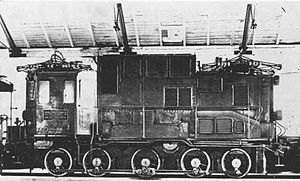BBÖ 1180
| BBÖ 1180 | |
|---|---|
|
BBÖ 1180 with dismantled rod triangle
|
|
| Numbering: | BBÖ 1180.001 |
| Number: | 1 |
| Manufacturer: | Floridsdorf , Ganz & Co. from Budapest |
| Year of construction (s): | 1925 |
| Retirement: | Returned to the manufacturer in 1925 |
| Axis formula : | E. |
| Gauge : | 1435 mm ( standard gauge ) |
| Length over buffers: | 10,800 mm |
| Total wheelbase: | 6,500 mm |
| Service mass: | 73.5 t |
| Friction mass: | 73.5 t |
| Wheel set mass : | 14.65 t |
| Top speed: | 67 km / h |
| Hourly output : | 1470 kW at 33 km / h |
| Starting tractive effort: | 184 kN |
| Hourly traction: | 147 kN at 33 km / h 106 kN at 50 km / h 78 kN at 67 km / h |
| Driving wheel diameter: | 1,070 mm |
| Motor type: | phase- and pole-changing asynchronous motor |
| Power system : | 15 kV / 16⅔ Hz |
| Number of traction motors: | 2 |
| Drive: | Kandó articulated frame drive |
| Locomotive brake: | Vacuum brake, air brake |
| Train brake: | Air brake |
The BBÖ 1180.001 was an electric locomotive of the Austrian Federal Railways BBÖ, which was returned to the manufacturer without ever having run. The locomotive was designed as a so-called converter locomotive , in which the single-phase alternating current from the catenary on the locomotive was converted into a three-phase alternating current to supply the traction motors with the help of a rotating converter .
history
In 1923, Ganz & Co. in Budapest , under the direction of Kandó, built a test locomotive that had a high-voltage phase converter instead of a transformer. The converter was as synchronous - rotary converters designed with oil-cooled stator winding. The machine has been successfully tested under 15 kV / 50 Hz. Disadvantages were the complicated structure of the mechanical part and that the locomotive could only be operated at a small number of synchronous continuous speeds. The difference in performance compared to the Austrian locomotives, however, was considerable: it had an output of 2,000 kW, while the BBÖ 1080 , which was only 5 t lighter and had the same axle formula, developed an output of only 1,020 kW. The BBÖ therefore wanted to investigate whether similar results could also be achieved below 15 kV / 16⅔ Hz and ordered an express train locomotive, the BBÖ 1470.001 and a freight train locomotive, the 1180.001.
construction
The mechanical part was manufactured by the Floridsdorf locomotive factory , which contrary to customary practice also acted as the main supplier. The reason was probably that the supplier of the electrical part, Ganz & Co., was based in Budapest, i.e. abroad.
testing
The 1180.001 and 1470.001 were delivered in 1925 and stationed in Bludenz . The problems during the test drives with the 1470.001 meant that the 1180.001 had to serve as a spare part dispenser for the 1470.001. The two machines were returned to the suppliers in the same year without the 1180.001 ever running independently. The vehicles remained in Bludenz for over ten years. Only then was the Floridsdorf locomotive factory able to agree on replacement services with Ganz & Co.
technology
The contact line voltage was connected directly to the primary winding of the oil-cooled synchronous single-armature converter via the pantograph, which supplied the two asynchronous traction motors with 2-, 3- or 4-phase three-phase current. The motors were pole-changing and could be operated with 12, 8 or 6 poles. The speeds of the continuous drive levels were 16 km / h, 25 km / h, 33 km / h, 50 km / h and 67 km / h. The two traction motors were in the locomotive body and drove the drive axles on the already from the BBÖ 1280 known Kandó-pinion drive on.
literature
- Richard Rotter, Helmut Petrovitsch, traction vehicles of Austrian railways - electric locomotives and multiple units , alba Verlag, Düsseldorf, 1990, ISBN 3-87094-132-4
Web links
- Pictures of the BBÖ 1180 and 1470 on eisenbahn-bilder.com
Individual evidence
- ^ A b Karl Sachs: Electric Vollbahnlokomotiven: A manual for practice as well as for students . Springer-Verlag, 2013, ISBN 978-3-642-51847-8 , pp. 383 ( limited preview in Google Book search).
- ^ A b Karl Sachs: Electric Vollbahnlokomotiven: A manual for practice as well as for students . Springer-Verlag, 2013, ISBN 978-3-642-51847-8 , pp. 405 ( limited preview in Google Book search).
